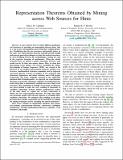Representation theorems obtained by mining across web sources for hints
Abstract
A representation theorem relates different mathematical structures by providing an isomorphism between them: that is, a one-to-one correspondence preserving their original properties. Establishing that the two structures substantially behave in the same way, representation theorems typically provide insight and generate powerful techniques to study the involved structures, by cross-fertilising between the methodologies existing for each of the respective branches of mathematics. When the related structures have no obvious a priori connection, however, such results can be, by their own nature, elusive. Here, we show how data-mining across distinct web sources (including the Online Encyclopedia of Integer Sequences, OEIS), was crucial in the discovery of two original representation theorems relating event structures (mathematical structures commonly used to represent concurrent discrete systems) to families of sets (endowed with elementary disjointness and subset relations) and to full graphs, respectively. The latter originally emerged in the apparently unrelated field of bioinformatics. As expected, our representation theorems are powerful, allowing to capitalise on existing theorems about full graphs to immediately conclude new facts about event structures. Our contribution is twofold: on one hand, we illustrate our novel method to mine the web, resulting in thousands of candidate connections between distinct mathematical realms; on the other hand, we explore one of these connections to obtain our new representation theorems. We hope this paper can encourage people with relevant expertise to scrutinize these candidate connections. We anticipate that, building on the ideas presented here, further connections can be unearthed, by refining the mining techniques and by extending the mined repositories.
Citation
Caminati , M & Kuster Filipe Bowles , J 2023 , Representation theorems obtained by mining across web sources for hints . in A Gokhale & M Guizani (eds) , Proceedings : 6th international conference on information and computer technologies (ICICT 2023), Raleigh, United States, Mar 24 - Mar 26, 2023 . International conference on inventive computation technologies (ICICT) , IEEE Computer Society , Piscataway, NJ , pp. 203-210 , International Conference on Inventive Computation Technologies (ICICT) , Raleigh , North Carolina , United States , 24/03/23 . https://doi.org/10.1109/icict58900.2023.00041 conference
Publication
Proceedings
ISSN
2769-4550Type
Conference item
Description
Funding: JKFB partially supported by the Austrian Science Fund under FWF Meitner project M-3338.Collections
Items in the St Andrews Research Repository are protected by copyright, with all rights reserved, unless otherwise indicated.

